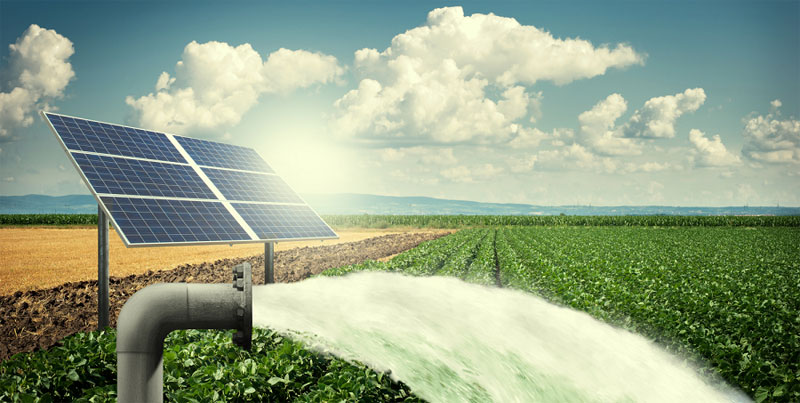Solar Pumping in India
Amit Kumar. Feb 26 ‘2017.
(This article expresses the opinions and suggestions of the author, based on ground level experiences with promoting solar pumping solutions in India).
The Challenge:
Bharat – home to the majority of India’s population is mainly made up of small and marginal farmers. In many states of the nation, these farmers continue to struggle with getting enough water for their fields. Many of them have adequate levels of ground water, but are unable to irrigate their crop – because they do not have an electricity connection. Currently wait times for agricultural connections can be as much as 7 or 8 years.
The Visionary Goals of our PM:
Convergence between economy, ecology and energy should define our future: PM Modi
(scroll to end of the article to watch video – PM Modi’s address at the launch of International Solar Alliance)
Our Hon. Prime Minister, Narendra bhai Modi, has set a goal of doubling farmers incomes in India by 2022. Irrigation will be a key player in ensuring this goal is met. While this is obvious in the case of farmers without electricity who are not able to irrigate; solar pumping will play a critical role on income growth even for those who have a connection (let me explain). Agricultural connections on an average supply 4 to 5 hours of electricity a day. Many cash crops that can generate better income for the farmers, require more irrigation than this. With solar pumping, farmers are able to irrigate their crops for a longer duration and grow their income.
Solution:
A sustainable, immediately accessible and cost effective way for farmers to irrigate their fields. Solar Pumping is an ideal solution for a sun-soaked and fossil energy challenged nation like us.
Government support:
Various ministries of the nation including MNRE and the Agriculture ministry, have taken concrete steps to support solar pumping. The largest subsidy driven program is the NABARD solar pumping program. With a stated goal of 30,000 pumps across the nation, it can truly make a difference. In addition there are various state level programs, which are not of this scale, but that also compliment the growth of irrigation with solar.
Opportunities for accelerated growth:
Our outreach has largely been in the state of Rajasthan. And our experiences shared below are more specific to this geography, but could be similar in other states as well. Our efforts included reaching out to farmers are well as Panchayats, Sarpanchs, and rural banking institutions
Awareness: Rural India by and large is still unaware of the solar pumping opportunity. Most farmers have never seen a solar pump in action. They are interested in the solar solution and can afford it, but hesitate to move ahead, fearing loss of their investment.
Demo models and tours to running solar pumping locations is the need of the hour. Manufacturers can play a role by offering a 30 day money back scheme. Since the technology is fool proof, the number of returns would be an extremely small number.
Financing: Despite a strong subsidy and financing program in place, rural branches of banks are still not in the loop on this program. There is concern about NPAs arising from these loans and an overall hesitation to process files. Processing times are stretched out over weeks or months. Also expected documentation varies by institution and in my opinion would put a startup financing documentation to shame. This is despite the fact that a solar pumping solution is an income generation asset which will have immediate growth in the farmers income (and hence the ability to repay). If KCCs can be financed with very little documentation, why should an income producing asset be so hard to get financing.
The financing process desperately needs an online platform owned and operated by MNRE or Ministry of Agriculture or Ministry of Finance. Banks that are keen on growing their secured income producing portfolio, plus gaining business of more prosperous farmers, plus supporting clean energy – will be the ones who will keenly pick more files from the system. With the loan risk factor shared by NABARD, banks have an excellent low risk product to grow their lending portfolio. If this centralized portal is open for multiple banks to access the applications and pick as many as they want, the ground level challenge of running from bank to bank will get eliminated. This could also spur more innovation in the financing products for solar pumps – currently there is only one option.
Marketplace: After sales support is critical to ensuring the long term growth of this sector. While the vast majority of manufacturers deliver quality products and support, some inferior imports and low grade products are also entering the market. These products when they stop working have an immediate impact on the perception of solar. As solar is in the early stages of adoption, clients usually say solar doesn’t work – they do not say Brand X or company Y’s product did not work. With word of mouth being the strongest communication channel in Bharat, the solar industry can ill afford the reputation risk. A centralized problem resolution call center can aim to solve this problem. Technical issues once registered here, can be then passed on to pre-approved local technicians (Surya Mitra’s) for handling.
The team at SuryaUrjaa.com is making a humble effort in meeting the above needs. But it is not enough and government level measurement and monitoring is needed to ensure a fair and successful growth of this sector.
Conclusion
A lot of India’s future is riding on the ability of Bharat to deliver more and better quality agriculture produce. Solar pumping can ensure that the farmer has enough water to irrigate his crop and double his income by 2022.
Next Steps
For more information and a discussion, drop a line to the author of this article – Amit –
admin at suryaurjaa.com. It will be a pleasure to discuss growth opportunities.
[svpVideo v=1]
